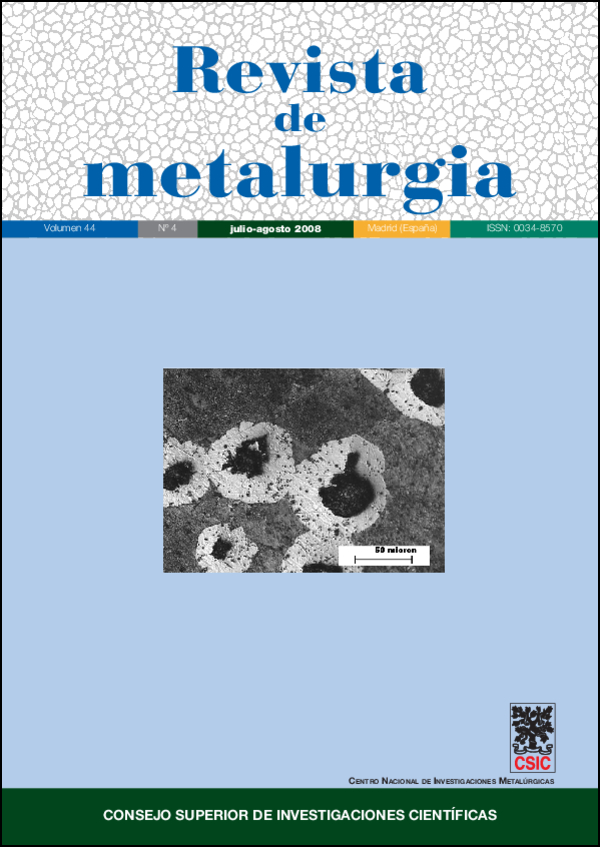How heat treatments influence behaviour under abrasion wear on a spheroidal graphite cast iron obtained by adding boron
DOI:
https://doi.org/10.3989/revmetalm.2008.v44.i4.118Keywords:
Wear, Hardness, Microstructure, Boron cast iron, Cast ironAbstract
By adding boron to the liquid metal, it is possible to obtain spheroidal graphite cast iron without any need for special inoculants. The boron may be in metallic form; alternatively, borax, ferroboron, boron carbonate or borocalcium can be used. These alloys as cast present a pearlite matrix with more or less spheroidal graphite, which is usually edged in ferrite that has markings in the shape of bull’s eye. With normalising, the ferrite edges are eliminated. Thus, a pearlite matrix is achieved. Annealing results in an entirely ferrite matrix; quenching and tempering produce a tempered martensite matrix.This study measures the behaviour under wear of this alloy as cast, normalised, annealed, quenched and tempered . A “pin on disk” test is employed; load and speed conditions, as well as the pin type, are kept constant. Moreover, wear is calculated through weighing, and the variation for the friction coefficient is determined in each case.
Downloads
References
[1] H. E. Henderson, ASTM Special Technical Publication 455 (1969) 29-53.
[2] A. Suárez-Sanabria y J. Fernández-Carrasquilla. Rev. Metal. Madrid 42 (2006) 18-31.
[3] R. Gonzaga-Cinco y J. Fernández-Carrasquilla. Rev. Metal Madrid 42 (2006) 91-105.
[4] I. Fernández-Pariente y F. J. Belzunce-Varela. Rev. Metal. Madrid 42 (2006) 279-286
[5] S.L. Liu, C. R. Loper y T. H. Witter, Trans. Am. Foundrymen’s Soc. 100 (1992) 899-906.
[6] S.V. Subramanian, D.A.R. Kay y G. R. Purdy, Trans. Am. Foundrymen’s Soc. 90 (1982) 589- 603.
[7] R. D. Schelleng, Mod. Cast. 52 (1967) 70-71.
[8] Quality control manual. Ductile Iron Society Publication, 1991
[9] H. Zhao y Q. Rao, Indian Foundry J. 43 (1997) 17-21.
[10] D.L. Ball, Trans. Am. Foundrymen’s Soc. 75 (1968), 428-432.
[11] J.D. Farquhar, Trans. Am. Foundrymen’s Soc. 87 (1979), 433-438.
[12] R. Castillo, V. Bermont y V. Martinez, Rev. Metal. Madrid 35 (1999) 329-334.
[13] Z.L. Lu, Y.X. Zhou, Q.C. Rao y Z.H. Jin, J. Mater. Proces. Tech. 116 (2001) 176-181. doi:10.1016/S0924-0136(01)01013-5
[14] L. C. Chang, I. C. Hsui, L. H. Chen y S. T. Lui, Wear 257 (2004) 1125-1132. doi:10.1016/j.wear.2004.07.011
[15] M. Hatate, T. Shaiota, N. Takahashi y K. Shimizu, Wear 251 (2001) 885-889. doi:10.1016/S0043-1648(01)00746-3
[16] A. S. M. A. Haseeb, A. Islam, M. A. Bepari, Wear 244 (2000) 15-19. doi:10.1016/S0043-1648(00)00404-X
[17] R.C. Donmarco, M.E. Sousa y J.A. Sikora, Wear 257 (2004) 1185-1192. doi:10.1016/j.wear.2004.08.002
[18] F. E. Kennedy, Wear 100 (1984) 453-76. doi:10.1016/0043-1648(84)90026-7
[19] E. Takeuchi, Wear 19 (1972) 267-76. doi:10.1016/0043-1648(72)90119-6
[20] K. Hirasata, K. Hayashi y H. Matsunami, Tribology Series 41 (Tribological Research and Design for Engineering Systems) Elsevier Science, 2003, pp. 643-652.
[21] A. Varela, A. García, V. Blázquez, C. Camba, S. Zaragoza y J.L. Mier, Libro de actas del Congreso Ibertrib 2007.
Downloads
Published
How to Cite
Issue
Section
License
Copyright (c) 2008 Consejo Superior de Investigaciones Científicas (CSIC)

This work is licensed under a Creative Commons Attribution 4.0 International License.
© CSIC. Manuscripts published in both the printed and online versions of this Journal are the property of Consejo Superior de Investigaciones Científicas, and quoting this source is a requirement for any partial or full reproduction.
All contents of this electronic edition, except where otherwise noted, are distributed under a “Creative Commons Attribution 4.0 International” (CC BY 4.0) License. You may read the basic information and the legal text of the license. The indication of the CC BY 4.0 License must be expressly stated in this way when necessary.
Self-archiving in repositories, personal webpages or similar, of any version other than the published by the Editor, is not allowed.
















